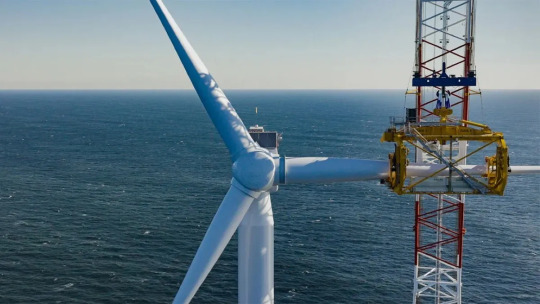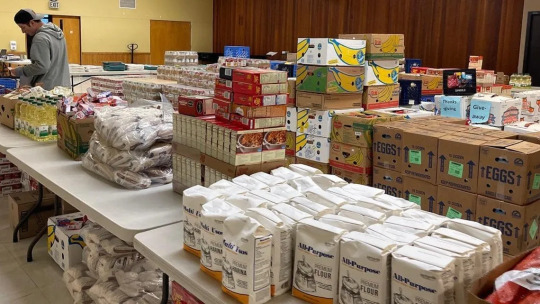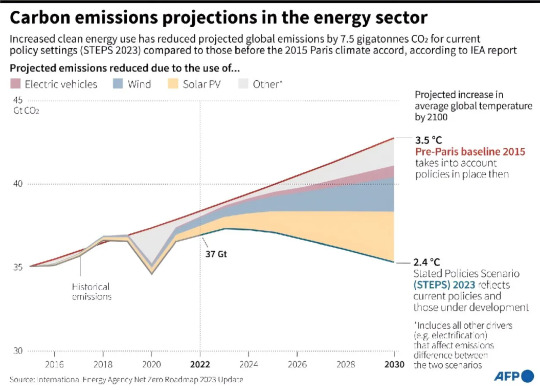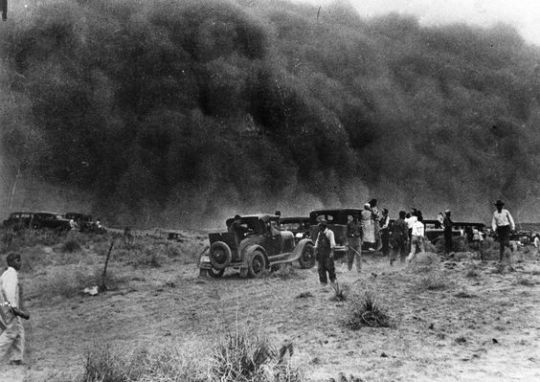#Global Wind Day 2023
Explore tagged Tumblr posts
Text
वैश्विक पवन दिवस पहली बार 2007 में यूरोपीय पवन ऊर्जा संघ (EWEA) और वैश्विक पवन ऊर्जा परिषद (GWEC) द्वारा स्थापित किया गया था। पहल का उद्देश्य पवन ऊर्जा को बढ़ावा देना और जनता को इसके लाभों के बारे में शिक्षित करना है। तब से, उत्सव ने वैश्विक मान्यता प्राप्त की है और पवन ऊर्जा की क्षमता के बारे में जागरूकता बढ़ाने में एक आवश्यक घटना बन गई है।
#वैश्विक पवन दिवस#Global Wind Day#Global Wind Day 2023#wind day#The Origins of Global Wind Day#The Significance of Global Wind Day
0 notes
Text
Masterpost: Reasons I firmly believe we will beat climate change
Posts are in reverse chronological order (by post date, not article date), mostly taken from my "climate change" tag, which I went through all the way back to the literal beginning of my blog. Will update periodically.
Especially big deal articles/posts are in bold.
Big picture:
Mature trees offer hope in world of rising emissions (x)
Spying from space: How satellites can help identify and rein in a potent climate pollutant (x)
Good news: Tiny urban green spaces can cool cities and save lives (x)
Conservation and economic development go hand in hand, more often than expected (x)
The exponential growth of solar power will change the world (x)
Sun Machines: Solar, an energy that gets cheaper and cheaper, is going to be huge (x)
Wealthy nations finally deliver promised climate aid, as calls for more equitable funding for poor countries grow (x)
For Earth Day 2024, experts are spreading optimism – not doom. Here's why. (x)
Opinion: I’m a Climate Scientist. I’m Not Screaming Into the Void Anymore. (x)
The World’s Forests Are Doing Much Better Than We Think (x)
‘Staggering’ green growth gives hope for 1.5C, says global energy chief (x)
Beyond Catastrophe: A New Climate Reality Is Coming Into View (x)
Young Forests Capture Carbon Quicker than Previously Thought (x)
Yes, climate change can be beaten by 2050. Here's how. (x)
Soil improvements could keep planet within 1.5C heating target, research shows (x)
The global treaty to save the ozone layer has also slowed Arctic ice melt (x)
The doomers are wrong about humanity’s future — and its past (x)
Scientists Find Methane is Actually Offsetting 30% of its Own Heating Effect on Planet (x)
Are debt-for-climate swaps finally taking off? (x)
High seas treaty: historic deal to protect international waters finally reached at UN (x)
How Could Positive ‘Tipping Points’ Accelerate Climate Action? (x)
Specific examples:
Environmental Campaigners Celebrate As Labour Ends Tory Ban On New Onshore Wind Projects (x)
Private firms are driving a revolution in solar power in Africa (x)
How the small Pacific island nation of Vanuatu drastically cut plastic pollution (x)
Rewilding sites have seen 400% increase in jobs since 2008, research finds [Scotland] (x)
The American Climate Corps take flight, with most jobs based in the West (x)
Waste Heat Generated from Electronics to Warm Finnish City in Winter Thanks to Groundbreaking Thermal Energy Project (x)
Climate protection is now a human right — and lawsuits will follow [European Union] (x)
A new EU ecocide law ‘marks the end of impunity for environmental criminals’ (x)
Solar hits a renewable energy milestone not seen since WWII [United States] (x)
These are the climate grannies. They’ll do whatever it takes to protect their grandchildren. [United States and Native American Nations] (x)
Century of Tree Planting Stalls the Warming Effects in the Eastern United States, Says Study (x)
Chart: Wind and solar are closing in on fossil fuels in the EU (x)
UK use of gas and coal for electricity at lowest since 1957, figures show (x)
Countries That Generate 100% Renewable Energy Electricity (x)
Indigenous advocacy leads to largest dam removal project in US history [United States and Native American Nations] (x)
India’s clean energy transition is rapidly underway, benefiting the entire world (x)
China is set to shatter its wind and solar target five years early, new report finds (x)
‘Game changing’: spate of US lawsuits calls big oil to account for climate crisis (x)
Largest-ever data set collection shows how coral reefs can survive climate change (x)
The Biggest Climate Bill of Your Life - But What Does It DO? [United States] (x)
Good Climate News: Headline Roundup April 1st through April 15th, 2023 (x)
How agroforestry can restore degraded lands and provide income in the Amazon (x) [Brazil]
Loss of Climate-Crucial Mangrove Forests Has Slowed to Near-Negligable Amount Worldwide, Report Hails (x)
Agroecology schools help communities restore degraded land in Guatemala (x)
Climate adaptation:
Solar-powered generators pull clean drinking water 'from thin air,' aiding communities in need: 'It transforms lives' (x)
‘Sponge’ Cities Combat Urban Flooding by Letting Nature Do the Work [China] (x)
Indian Engineers Tackle Water Shortages with Star Wars Tech in Kerala (x)
A green roof or rooftop solar? You can combine them in a biosolar roof — boosting both biodiversity and power output (x)
Global death tolls from natural disasters have actually plummeted over the last century (x)
Los Angeles Just Proved How Spongy a City Can Be (x)
This city turns sewage into drinking water in 24 hours. The concept is catching on [Namibia] (x)
Plants teach their offspring how to adapt to climate change, scientists find (x)
Resurrecting Climate-Resilient Rice in India (x)
Edit 1/12/25: Yes, I know a bunch of the links disappeared. I'll try to fix that when I get the chance. In the meantime, read all the other stuff!!
Other Masterposts:
Going carbon negative and how we're going to fix global heating (x)
#climate change#climate crisis#climate action#climate emergency#climate anxiety#climate solutions#fossil fuels#pollution#carbon emissions#solar power#wind power#trees#forests#tree planting#biodiversity#natural disasters#renewables#renewable electricity#united states#china#india#indigenous nations#european union#plant biology#brazil#uk#vanuatu#scotland#england#methane
2K notes
·
View notes
Text
The Best News of Last Week - November 28, 2023
🐑 - Why did Fiona the sheep become a mountaineer? She was tired of the "baa-d" jokes at sea level!
1. Pope Francis dines with transgender women for Vatican luncheon

Pope Francis hosted a group of transgender women — many of whom are sex workers or migrants from Latin America — to a Vatican luncheon for the Catholic Church's "World Day of the Poor" last week.
The pontiff and the transgender women have formed a close relationship since the pope came to their aid during the COVID-19 pandemic, when they were unable to work. Now, they meet monthly for VIP visits with the pope and receive medicine, money and shampoo any day, according to The Associated Press.
2. New York just installed its first offshore wind turbine

The first wind turbine installation at South Fork Wind, New York State’s first offshore wind farm, is complete.
The 130-megawatt (MW) South Fork Wind will be the US’s first completed utility-scale wind farm in federal waters.
3. Anonymous businessman donates $800k to struggling food bank

But this Thanksgiving, a longtime prayer of food bank leaders was finally answered: an anonymous benefactor donated the full $800,000 they needed to move out of a facility they've long outgrown. That benefactor, however, preferred to stay anonymous.
"Very private company, really don't want attention," said Debbie Christian, executive director of the Auburn Food Bank. "It's a goodhearted person that just wants to see the work here continue, wants to see it expand."
4. Empowering woman saving hopes and mental health of suffering Ukrainian kids

Kenza Hadij-Brahim is at the forefront of promoting Circle of Toys
Hadj-Brahim is helping to launch the Circle of Toys initiative. A project that provides Ukrainian children in need of some normality with preloved toys. This new initiative connects people with old toys they might otherwise throw away, with Ukrainian families in need who want to provide some comfort to their children in this distressing time.
Find Refuge said : “The endeavour is driven by a sincere purpose: spark joy, foster play, and bring a hint of normalcy back to the young lives in Ukraine.”
5. TWO LOST CITIES HIDDEN FOR CENTURIES WERE JUST DISCOVERED IN BOLIVIA

Researchers have found these areas not only housed structures and pyramids but it has been uncovered that there were advanced irrigation systems, earthworks, large towns, causeways, and canals that cover miles.
Dr. Heiko Prümers from the German Archaeological Institute, who was also involved in the study comments that “this indicated a relatively dense settlement in pre-Hispanic times. Our goal was to conduct basic research and trace the settlements and life there. The research sheds light on the sheer magnitude and magnificence of the civic-ceremonial centers found buried in the forest”.
6. Sheep dubbed Fiona rescued from cliff in Scotland where she was stuck for more than 2 years
youtube
And at last, some positive climate news:
7. Three positive climate developments

Heating
When the Paris Agreement was adopted, the global reliance on fossil fuels placed the world on a path towards a 3.5C rise in temperature by 2100. Eight years on, country commitments to reduce their carbon footprints have pulled that down slightly, putting the world on a path for a 2.5C to 2.9C by the end of the century.
Peak emissions
Annual greenhouse gas emissions responsible for climate change have risen roughly nine percent since COP21, according to UN data. But the rate of the increase has slowed significantly. Recent estimates by the Climate Analytics institute find global emissions could peak by 2024
Rising renewables
Three technologies—solar, wind and electric vehicles—are largely behind the improved global warming estimates since 2015.
---
That's it for this week :)
This newsletter will always be free. If you liked this post you can support me with a small kofi donation here:
Buy me a coffee ❤️
Also don’t forget to reblog this post with your friends.
816 notes
·
View notes
Text
NEWS -
ABOUT EARTHSHOT 2024 IN SOUTH AFRICA -
Africa was chosen as the fourth continent to host the star-studded event in acknowledgement of its enormous contribution to enhancing climate action and tackling the biggest environmental challenges our planet faces. Despite contributing the least to global warming and having the lowest emissions, Africa is the most vulnerable continent to the impacts of a changing climate.
The number of African-based nominations has doubled between 2023 and 2024, with over 400 nominations from African-led solutions and another 350 with operations and impact in Africa.
Throughout Earthshot Week – which will run between Monday 4th and Thursday 7th November – these African innovators and all those contributing to efforts to protect our planet will be celebrated.
Some things to expect from this year's awards -
The show will open with an exclusive performance by Lebo M. of Circle of Life from The Lion King, pre-recorded at the top of Table Mountain.
For the first time, over 1000 members of the public have been invited to the Awards Ceremony in Cape Town. Attendees have been invited in recognition of their long-serving commitment to their local communities.
The Earthshot Prize will host its first ever Green Carpet Event, which will be broadcast live globally via the Earthshot Prize’s YouTube channel, with hosts Ebuka Obi-Uchendu and Moozlie. Guests have been asked to ‘rewear’ their wardrobe or spotlight African designers in order to highlight the importance of sustainable fashion and local creatives.
The City of Cape Town is supplying Renewable Energy Certificates from Darling Wind Farm, meaning that for every kWh of electricity used during the event, a kWh of locally produced renewable energy is allocated.
To celebrate Earthshot Week taking place in South Africa, Table Mountain and other Cape Town landmarks will be lit green from 4th-7th November.
Those visiting Cape Town over the coming days will also see The Earthshot Prize at several of the city’s famous yellow frames which encourage visitors and locals to enjoy the beauty of Table Mountain. Visitors can explore a public exhibition at the Sea Point celebrating African climate heroes who are using their creativity, time and talent to fix the world’s problems, one ingenious solution at a time.
#news#prince of wales#the prince of wales#prince william#william prince of wales#british royal family#royalty#brf#british royalty#Earthshot24#earthshot prize#earthshot
41 notes
·
View notes
Text
Nine books that I— have been putting on hold since forever— want to read/finish in 2025
in no particular order:
The Adventures of Amina Al-Sirafi (1)
The Radiant Emperor Duology (2)
Cinder (1)
The Sword of Kaigen (1)
Babel (1)
The Biology of Human Survival: Life and Death in Extreme Environments (1)
A Reaper At The Gates (1)
Gideon The Ninth (1)
More about the books below because, mainly, the summaries are spot on (and kind of represent my taste / why I'm terribly intrigued to read them):
✨️🧋🥡📖✨️
The Adventures of Amina Al-Sirafi by S. A. Chakraborty
Amina Al-Sirafi is a middle-aged single mother with bad knees who lives in a modest country house and minds her own business. She was also one of the most fearsome pirates who ever sailed the Indian Ocean, at least until strange magic claimed a beloved crewmember and drove her to retire on dry land.
2023 historical fantasy.
—
The Radiant Emperor Duology by Shelley Parker-Chan
She Who Became The Sun
Set in an alternate China, She Who Became the Sun is a fascinating genderqueer retelling of the founding of the Ming dynasty, follows Zhu Chongba who had to become a monk even though she's only a little girl for her survival, from childhood to early adulthood, using her dead brother's identity, fighting to claim his destiny as her own.
2021 historical fantasy.
&
The sequel: He Who Drowned The World
Got the hardcopy as a birthday present for me because I couldn't stop yapping about it to my friend 🥹🥹🥹

—
Cinder by Marissa Meyer
Cinder is a cyborg mechanic living in New Beijing who, along with her best friend (a robot named Iko) and sister (a fully human gal named Pearl), fall in love with Prince Kai. But, life isn't all cleaning and singing, there's a ravaging plague and crippling poverty. The plague can strike anyone at any time.
2012. Part of The Lunar Chronicles.
—
The Sword of Kaigen: A Theonite War Story by M. L. Wang
Better to die sharp in war than rust through a time of peace. A mother struggling to repress her violent past;
A son struggling to grasp his violent future;
A father blind to the danger that threatens them all.
When the winds of war reach their peninsula, will the Matsuda family have the strength to defend their empire? Or will they tear each other apart before the true enemies even reach their shores? High on a mountainside at the edge of the Kaigenese Empire live the most powerful warriors in the world, superhumans capable of raising the sea and wielding blades of ice. For hundreds of years, the fighters of the Kusanagi Peninsula have held the Empire's enemies at bay, earning their frozen spit of land the name 'The Sword of Kaigen.'
Set on the planet Duna, on Mount Takayubi in the Kaigenese Empire, the story revolves around the populace of a remote, highly patriarchal village that, for generations, has raised and trained swordsmen with magical, almost supernatural abilities to fight enemies that invade the realm.
—
Babel by R. F. Kuang
Robin Swift, orphaned by cholera in Canton, is brought to London by the mysterious Professor Lovell. There, he trains for years in Latin, Ancient Greek, and Chinese, all in preparation for the day he'll enroll in Oxford University's prestigious Royal Institute of Translation—also known as Babel.
Babel take place in an alternative-reality in which Britain's global economic and colonial supremacy are fueled by the use of magical silver bars.
—
The Biology of Human Survival: Life and Death in Extreme Environments
Solely for writing reference since I am a deprived and amateur writer first, human second, after all.
—
A Reaper at The Gates by Sabaa Tahir
3rd book of Ember Quartet. To understand this, you must read its 1st book: An Ember in The Ashes (inspired by Ancient Rome, the story follows a girl named Laia spying for rebels against the reigning empire in exchange for their help in rescuing her captive brother; and a boy named Elias struggling to free himself from being an enforcer of a tyrannical regime.)
—
Gideon The Ninth by Tamsyn Muir
1st book of The Locked Tomb Series. Brought up by unfriendly, ossifying nuns, ancient retainers, and countless skeletons, Gideon is ready to abandon a life of servitude and an afterlife as a reanimated corpse.
That would be all! Thank you so much for tagging me, @kanronotatsu ! ! ! 📚🔍
Fingers crosed I get to at least finish one or two, this year. Now, I shall tag my friends @ikjun @dykealloy @reineyday @radiashen @lunaticus @beguilewritesstuff and YOU, whoever is reading this, are also welcome to share it with us ! ! ! :D
#Book List#Books To Read#genuinely can't care less about the thought that someone might label me as a pick-me#but i will definitely bring and read that book everywhere i go#Ask Game#nine books to finish
7 notes
·
View notes
Text
HOW FAST DOES THE EARTH SPIN??
Blog#331
Wednesday, September 13th, 2023
Welcome back,
To answer the question of how fast Earth spins, you need to know two things: how long it takes to make a full rotation, and Earth’s circumference. The time it takes Earth to rotate so the sun appears in the same position in the sky, known as a solar day, is 24 hours. However, the time it takes Earth to complete one full rotation on its axis with respect to distant stars is actually 23 hours 56 minutes 4.091 seconds, known as a sidereal day.

With this information, to work out how fast Earth is spinning we need only our planet’s circumference. At the equator, its circumference is roughly 40,075 kilometres, so dividing this by the length of day means that, at the equator, Earth spins at about 1670 kilometres per hour.

However, this speed of rotation isn’t consistent across the planet. As you move north or south, the circumference of Earth gets smaller, so the speed of spin reduces until it reaches its slowest at both poles. And all of this is nothing compared with the 107,000 kilometres per hour at which Earth orbits the sun.
If we are travelling so fast through space, why can’t we feel it?

Simply put, as Earth is spinning at a constant speed, so does everything on it. Travelling at the same speed means we cannot feel the spin. It is like driving a car. Even though you are moving, you aren’t aware of speed because it is constant. Only when you change speeds do you notice you are travelling, like putting your foot on the accelerator or making an emergency stop.

A change in speed has been happening here on Earth, but it is far too slow to notice. Millions of years ago, one Earth day was about 22 hours, and Earth’s speed has been dropping for more than a billion years, with days increasing by around 2 milliseconds every century.

This slow down is caused by friction created by the ocean currents, tides and wind pulling on Earth’s surface. However, global warming may speed things up again. As sea levels rise, this change in mass could result in Earth spinning faster and reducing the length of each day by 0.12 milliseconds, which would have dramatic effects on the calibration of atomic clocks and GPS systems.

What if Earth were to stop spinning?
Without a huge external force, this is impossible. But, if Earth were to stop spinning, the atmosphere would continue to spin at the speed of Earth’s rotation, so anything not fixed to the surface, including trees and buildings, would be swept away by the strong winds.
Each side of the planet would get six months of continuous sunlight and six months of darkness.

Without the centrifugal force of the spin, the oceans would gradually move towards the poles, creating a huge supercontinent across the equator. But we wouldn’t be flung off Earth. Gravity and the centrifugal force of Earth’s spin keep us grounded. In order for us to feel weightless, the centrifugal force would need to be ramped up. At the equator, Earth would need to spin at 28,437 kilometres per hour for us to be lifted off into space.
Originally published on newscientist.com
COMING UP!!
(Saturday, September 16th, 2023)
"HOW DO WE KNOW THE UNIVERSE IS INFINITE??"
#astronomy#outer space#alternate universe#astrophysics#universe#spacecraft#white universe#space#parallel universe#astrophotography#beautiful earth#earth#earth science#the strong nuclear force#gravitational force#gravity#gravitational waves#dark energy#sun#star#science#solar system
89 notes
·
View notes
Text
Excerpt from this article from The New Yorker, written by Bill McKibben:
Living through the onset of rapid global warming involves learning to roll with the punches. Increasingly, those are quite real and painful—this year saw, again, an accelerating toll of flood and drought. But, even for climate scientists sequestered in the lab, life increasingly seems like a series of bewildering blows.
As 2024 began, we’d just finished the most remarkable year in the planet’s modern climate history—2023 had shattered every global record for temperature, with researchers firm in the conviction that our planet had seen its hottest average temperatures in at least a hundred and twenty-five thousand years. But, even as they watched the mercury soar, they weren’t completely sure why: temperatures seemed to be rising even before an El Niño warming in the Pacific fully kicked in. In a remarkably candid essay this March in Nature, NASA’s chief climatologist, Gavin Schmidt, said, “The 2023 temperature anomaly has come out of the blue, revealing an unprecedented knowledge gap perhaps for the first time since about 40 years ago, when satellite data began offering modellers an unparalleled, real-time view of Earth’s climate system.” If temperatures hadn’t settled back to something more like a consistent rise by late summer 2024, he noted, that would imply “that a warming planet is already fundamentally altering how the climate system operates, much sooner than scientists had anticipated.”
In the event, this August was the warmest August on record, and most of the other months of 2024 also broke records; it now seems certain that, when meteorological officials announce their results early in January, this will again have been the hottest year ever measured. Scientists still can’t explain what’s causing the spike, which sits atop the steady ramp in temperature over the past few decades. As Schmidt said in an October interview with Elizabeth Kolbert, “it’s still pretty much, I would say, amateur hour in terms of assessing” what’s going on. The proffered explanations—the eruption of a submarine volcano in the South Pacific that put a lot of heat-trapping water vapor into the air, the phase-out of high-sulfur fuels in oceangoing ships that reduced heat-reflecting pollution—don’t seem large enough to account for what the thermometers are measuring; it’s possible that we may have tripped some switches we don’t understand in the global climate system.
What we do understand is bad enough. In September, Hurricane Helene swept across the Gulf of Mexico, turning from a tropical storm into a Category 4 hurricane in barely more than a day—the kind of “rapid intensification” that researchers increasingly see as a hallmark of a warming ocean. It moved so fast that it carried the freight of rain that it picked up over the record-hot waters of the Gulf far inland; in the mountains just north of Asheville, radar estimates suggested rainfall totals of up to forty inches. That water inundated the cricks and hollows of southern Appalachia—the death toll from the storm sits at two hundred and forty-one (making it the deadliest to hit the U.S. since Maria devastated Puerto Rico, in 2017), and the economic damage is nearing a hundred billion dollars, making it one of the costliest storms since Katrina. But the pictures from a ravaged North Carolina looked an awful lot like pictures from devastated parts of southern Europe or northern Africa or Brazil or Southeast Asia—if you look on YouTube, you can find a near-daily flood of flood pictures, with floating cars careening down the streets of mountain towns.
There seems to be just one way left to even start to slow down that torrent, and that’s to rapidly replace coal, gas, and oil with sun, wind, and batteries—and if you’re trying to avoid existential despair, there are stories and numbers this year worth focussing on. Solar power expanded so rapidly in 2023 (eighty-six per cent up on 2022 worldwide) that some wondered whether the charge could continue this year; it did, with the best guess being we will see a further growth of nearly thirty per cent this year. We’ve clearly moved into the steep part of the S-curve of clean-energy expansion, where even the most optimistic forecasts are consistently surpassed, and at the moment we appear to be installing a gigawatt’s worth of photovoltaic panels (roughly the size of a nuclear power plant) every eighteen hours or so.
9 notes
·
View notes
Text
The Apocalyptic August Jam is here!

TW: This game jam may be triggering as it may relate to global events occurring in the present day. The content of post-apocalyptic games are usually heavy, with themes of great loss of life and of nature in tow. Please don't feel the need, however, to be constrained to dark themes: human hope and change is a powerful theme in post-apocalyptic literature and art!
Welcome to the 6th monthly game jam that will be hosted on my itch.io page!
In this game jam, your objective is to create a game where apocalypses of any kind are the main focus. What does that mean?
Well, you could create a game where it's a fallout-style post apocalypse with mutated creatures, or you could create a Waterworld or Wind Waker styled game where climate changed has permanently altered the world, or you could create a game where the apocalypse actually gives humanity hope for a brighter future to learn from the sins of the past. It's up to you!
Your games can be tabletop games OR digital games. Anything that gets your mind in the realm of game design is all that matters to me!
IMPORTANT: All games made at any point in time are allowed, but it is HIGHLY encouraged to make games only while this game jam is active. This is a chance to exercise your creative skills AND join a game jam, not just one or the other!
ALSO IMPORTANT: Under no circumstances are people who submit games with bigoted tones, ideologies, or dogwhistles allowed in this game jam. If your work is bigoted in any way, it can and will be rejected for submission. You have no place in my community, and please do not play my games at your tables. Also, please no NSFW submissions (you know what I mean by that).
(This is part of a game jam series where, every month, I will host a game jam focused on a theme that begins with the same letter as the month. Please feel free, even after the game jam ends, to make your game if you didn’t meet the deadline. I believe in you!)
#ttrpg#indie ttrpg#trans#queer#indie#gamedev#game dev#dnd#cyberpunk#scifi#tabletop games#tabletop#tabletop gaming#ttrpg community#tabletop rpgs#tabletop roleplaying#tabletop rpg#video games#video game#game jam#itchio jam
53 notes
·
View notes
Text
Here be headcanons
It's happening! Kicking off the first day of 007 Fest 2023 with some MI6 worldbuilding headcanons for Headcanons Day (AKA the HCs crammed into my WIP to make sense of film-world MI6)
Q Branch is just a small part of Six (and everyone else thinks the double-oh programme is more trouble than it's worth)
Q Branch makes no sense. As film!Q is a shorthand for the mission support teams for narrative ease, Q Branch seems to run independently and Q himself is a polymath taking on all the roles.
Eh, I'm okay with genius Q because I love him 🤷 Other Q Branchers are all wildly smart and eccentric in their own ways. That's Q's hiring policy
Most analysis, missions, etc. are run through logical departments with hundreds of staff, which the problem children doubles-ohs and Q Branch build on for their specialist missions
Lots of Six staff don't like the double-ohs and Q Branch by extension – they burn through the budget, cause havoc and get away with multitudes, and a little more secrecy and intelligence in the SIS would be much preferred
Maybe it's for the best that Q Branch is away from HQ up-river at Millbank Pier (based on this excellent post)
Essentially, Mallory has hundreds, maybe thousands, of staff and assets globally, yet it's 1% of his staff that causes 99.9% of his headaches
Heracles isn't the first off-book project and it won't be the last
Mallory was used as a character to hang the Heracles plot on, but it leaves a lot of questions. Why was he even involved? Why isn't it the responsibility of the Defence Science and Technology Lab?
I figure all the UK's intelligence agencies have joint off-book operations like the Heracles research, some farmed out to private contractors, etc. So, Heracles isn't special, it's just that this secret got found out and had big consequences
Maybe Mallory had a hand in Obruchev defecting, so those consequences were extra personal
Also, imagine being Mallory: was Chair of the committee looking into MI6 shadiness, only to get hired as M and get tangled into all this shadiness
Q & Moneypenny besties: great; Q & Moneypenny & Tanner: even better
After Spectre, they didn't know who to trust, except one another. They keep Six running and they're each other's rocks and best bitching buddies
Q, despite what he says, is the most dramatic of the three. Moneypenny, of course, delights in winding Q up. Tanner isn't as catty as those two, except for when the mood strikes and he's the worst
Tanner gets swept up in various antics, often Bond's, along with Q and Moneypenny. However, he's perfected bland-faced innocence and Mallory never gives him grief for it. Q and Moneypenny find this very annoying
#007 fest 2023#headcanons#meta#james bond#quartermaster#eve moneypenny#bill tanner#gareth mallory#let me count the ways#teamcivilian#team civilian#headcanonday#headcanon day
66 notes
·
View notes
Text
Thoughts on 1989 vault tracks
Now I’ve sat with these vault tracks for a few days, my initial shock has passed and I like them, they are about her mental health and she is villain in her own story. She starts pointing out how everyone expects more from her than Harry and ends expecting more from him than herself ‘in is it over?’
I don’t think Taylor really shares every song that she wrote, shes curated a linear postscript to 1989:
In slut shes love struck by a gentleman and throwing caution for her own self preservation to the wind. His desirability is hurting her confidence. She cautions Harry who’s also so blissed out they are reckless and let their feelings be known to the world.
In say don’t go she’s not getting what she wants. He’s not telling her he loves her, which is age appropriate - but in the context of millions of fans wanting him a disappointment. I’d hope an older celebrity could navigate that better. In the context of the insecurities in Slut and Gold Rush asking for assurance that he loves her is understandable. It adds a great dimension to You are in Loves “you can hear it in the silence” she’s assuring herself he loves her. Harry had his own troubles that explain this to me, but let’s stay with Taylor’s self reflection narrative.
Now that we don’t talk has become one I love. The title tells us it’s over and time has passed. On face value it’s a diss to an ex, and it is, though the jibes are light to him but not to Taylor. But she’s admitting she’s a jealous petty ex who can’t let him go. Now she’s older, over it, but choose share her hurt at seeing him on a yacht with Kendall. It shows it was real, she did love him and she is vulnerable. Were dancing and laughing but she’s singing of regret, that she still cares about Harry’s anxiety, shes lonely, scorned and regretful. It’s real and sad.
In suburban legends she says she didn’t expect to fall in love - she came to be Taylor Swift: global superstar, he was for that too. There was no pretence of their priorities but she fell in love. She loved him, wanted to impress him dreamed of being a power couple. “When he holds her he holds her together”, she’s saying it’s not him “it’s me, I’m the problem, it’s me” She took a self preservation step to end something she loves.
In is it over now, it’s 300 coffees/blind dates later (10 months later) she’s still not over him, still feels possive. She ended it, this is of her own doing. She calls him a traitor but is asking if they can be together again. A pop star getting photographed dating 10 months out of a relationship is not unreasonable. He may date blondes, she dated British guys. In 2023 Taylor’s publicly dared 2 different guys post Joe. I think Taylor is self aware that she’s done all these things, with the benefit of time she’s sharing it. She tells of her suicidal ideation, she’s hoping to see him again. The title is a question and the last word is no, it’s not over.
I think on reflection Harry comes off fine (if you actually listen to all the words TikTok Swifities).
The lyrics are clear she ended it, the jealousy followed that event. She was in a bad headspace and wasn’t getting what she needed, time passed but she couldn’t move on. His crime was living after being dumped. Sticking with a Taylor-only story this is one of depression, insecurity and self-destruction. This is a time period we’ve never heard about before and we know why now, she was in a bad place. And I love her for sharing it.
Looking ahead the 1989 tour happened May - September, I’m sure bolstered her confidence. In miss Americana she also spoke of the impact of disordered eating on her stamina. NWDT is much later after the tour though, into her time with Calvin.
20 notes
·
View notes
Text
History of the American Dust Bowl




The series of intense dust storms, starting in 1930 and affecting the southern plains of the United States, has been called the greatest ecological disaster ever to happen on American soil. Over the next decade, tens-of-thousands of people were forced to leave their homes under apocalyptic conditions: rolling storms that blocked out the sun, wind laced with particles sharp enough to blind, dust filling up and choking the lungs of the young and old.
Starting with the trade embargo on Russia during World War I, the value of wheat in America and around the world sky-rocketed. The US Government made offers, real estate agents made promises, and an unusual wet season strengthened conviction: come to the prairie, grow wheat for our soldiers – there’s money to be made.
As large-scale farming expanded on the Prairies, inexperienced farmers or “sodbusters” replaced indigenous grasses with wheat crops. In less than ten years, over one hundred million acres of prairie land – overused by mechanized equipment and exacerbated by a severe drought – lost its topsoil and became an instant target for wind erosion. The country’s financial bedrock had been bled dry and now the land had been wrung out too.
In April 1935, on a day that became known as Black Sunday, around 4PM, a rapidly moving “black blizzard” hit Kansas. High winds at 100 miles an hour reportedly displaced 300,000 tons of topsoil. The rolling cloud was over 1,000 miles long, and covered 800 miles by the time it dissipated. Drivers were forced to take refuge in their cars, while other residents hunkered down in basements, barns, fire stations and tornado shelters, as well as under beds.
Folksinger Woody Guthrie, then 22, who sat out the storm at his Pampa, Texas home, recalled that “you couldn’t see your hand before your face.” Inspired by proclamations from some of his companions that the end of the world was at hand, he composed a song titled “So Long, It’s Been Good to Know Yuh.” Guthrie would also write other tunes about Black Sunday, including “Dust Storm Disaster.”
This was by far the worst storm suffered by those in the southern plains (an area reaching from the north of Texas, up the Dakotas and out to Kansas and Oklahoma), and as a result 17 people died, and three suffocated from the dirty wind. As a direct result of American greed and disregard for the natural world, the very skin of the Earth had been ripped up, leaving behind loose, dry soil – abandoned with no concern for conservation and regrowth. All of this, on top of a financial downturn that left over three millions of Americans without jobs, a home, or income.
For many, the Dust Bowl was the closest they ever got to the end of the world, nature’s apocalypse. Much of the Red Cross relief and FDR’s conservation efforts were focused on regrowing that topsoil and putting thousands of out-of-work farmers back on the land. By working in harmony with the land, the southern prairie was rebuilt, the dust storms died down, and the economy righted itself in the face of a new world war.
Apocalypse averted.
In 2023, global weather conditions are changing again due to man-made intervention and ecological carelessness. Year after year, heat records are broken and droughts last longer and longer. The earth is adapting to fit rising temperatures and expanding greenhouse gasses. It is evolving, much like a fungus, to meet its needs in a new climate.
Hopefully, this fic feels as foreign as an AU can, but as familiar as the show’s concern for global warming. There are no blind, clicking zombies in this fic, but there are monsters.
There are always monsters at the end of the world.
13 notes
·
View notes
Text
वैश्विक हवा दिवस एक वार्षिक आयोजन है जो विभिन्न देशों में 15 जून को मनाया जाता है। यह दिन वायु ऊर्जा और ऊर्जा संरक्षण को बढ़ावा देने का उद्देश्य रखता है। ग्लोबल विंड डे 2007 से मनाया जा रहा है और यह लोगों को हवा के महत्व के बारे में जागरूक करने का एक महान अवसर प्रदान करता है। इस लेख में, हम Global Wind Day 2023 के बारे में जानकारी प्राप्त करेंगे जैसे Date, History, Theme, Significance and other important information .
0 notes
Text
Green energy is in its heyday.
Renewable energy sources now account for 22% of the nation’s electricity, and solar has skyrocketed eight times over in the last decade. This spring in California, wind, water, and solar power energy sources exceeded expectations, accounting for an average of 61.5 percent of the state's electricity demand across 52 days.
But green energy has a lithium problem. Lithium batteries control more than 90% of the global grid battery storage market.
That’s not just cell phones, laptops, electric toothbrushes, and tools. Scooters, e-bikes, hybrids, and electric vehicles all rely on rechargeable lithium batteries to get going.
Fortunately, this past week, Natron Energy launched its first-ever commercial-scale production of sodium-ion batteries in the U.S.
“Sodium-ion batteries offer a unique alternative to lithium-ion, with higher power, faster recharge, longer lifecycle and a completely safe and stable chemistry,” said Colin Wessells — Natron Founder and Co-CEO — at the kick-off event in Michigan.
The new sodium-ion batteries charge and discharge at rates 10 times faster than lithium-ion, with an estimated lifespan of 50,000 cycles.
Wessells said that using sodium as a primary mineral alternative eliminates industry-wide issues of worker negligence, geopolitical disruption, and the “questionable environmental impacts” inextricably linked to lithium mining.
“The electrification of our economy is dependent on the development and production of new, innovative energy storage solutions,” Wessells said.
Why are sodium batteries a better alternative to lithium?
The birth and death cycle of lithium is shadowed in environmental destruction. The process of extracting lithium pollutes the water, air, and soil, and when it’s eventually discarded, the flammable batteries are prone to bursting into flames and burning out in landfills.
There’s also a human cost. Lithium-ion materials like cobalt and nickel are not only harder to source and procure, but their supply chains are also overwhelmingly attributed to hazardous working conditions and child labor law violations.
Sodium, on the other hand, is estimated to be 1,000 times more abundant in the earth’s crust than lithium.
“Unlike lithium, sodium can be produced from an abundant material: salt,” engineer Casey Crownhart wrote in the MIT Technology Review. “Because the raw ingredients are cheap and widely available, there’s potential for sodium-ion batteries to be significantly less expensive than their lithium-ion counterparts if more companies start making more of them.”
What will these batteries be used for?
Right now, Natron has its focus set on AI models and data storage centers, which consume hefty amounts of energy. In 2023, the MIT Technology Review reported that one AI model can emit more than 626,00 pounds of carbon dioxide equivalent.
“We expect our battery solutions will be used to power the explosive growth in data centers used for Artificial Intelligence,” said Wendell Brooks, co-CEO of Natron.
“With the start of commercial-scale production here in Michigan, we are well-positioned to capitalize on the growing demand for efficient, safe, and reliable battery energy storage.”
The fast-charging energy alternative also has limitless potential on a consumer level, and Natron is eying telecommunications and EV fast-charging once it begins servicing AI data storage centers in June.
On a larger scale, sodium-ion batteries could radically change the manufacturing and production sectors — from housing energy to lower electricity costs in warehouses, to charging backup stations and powering electric vehicles, trucks, forklifts, and so on.
“I founded Natron because we saw climate change as the defining problem of our time,” Wessells said. “We believe batteries have a role to play.”
-via GoodGoodGood, May 3, 2024
--
Note: I wanted to make sure this was legit (scientifically and in general), and I'm happy to report that it really is! x, x, x, x
#batteries#lithium#lithium ion batteries#lithium battery#sodium#clean energy#energy storage#electrochemistry#lithium mining#pollution#human rights#displacement#forced labor#child labor#mining#good news#hope
3K notes
·
View notes
Text
China’s path to reducing carbon emissions should be determined by China and not controlled by anyone else, President Xi Jinping told dozens of officials, at the same time as US climate envoy John Kerry is in Beijing seeking consensus on global warming.
Xi was speaking at a two-day national conference on ecological and environmental protection that started on Monday, Chinese state broadcaster CCTV reported on Tuesday night.
“China’s commitments are unswerving, but the path towards the goals as well as the manner, pace and intensity of efforts to achieve them should and must be determined by the country itself, rather than swayed by others,” he said.
“[We should] actively and steadily work toward carbon peaking and carbon neutrality, foster a clean, low-carbon, safe and efficient energy system, accelerate the formation of a new power system and strengthen the country’s capability of guaranteeing oil and gas security.”
Xi also urged the country to safeguard ecological security and nuclear and radiation safety to “ensure that the natural environment and conditions, which are the foundation of survival and development, are not threatened or damaged”.
He asked for a concerted legal, market, technological and policy effort to achieve his goals.
The conference was attended by all seven members of the Politburo Standing Committee, the pinnacle of the party’s decision-making apparatus, as well as a wide range of party and government bodies.
Kerry, whose four-day visit concludes on Wednesday, has met Premier Li Qiang and top diplomat Wang Yi, as he seeks consensus on the fight against climate change.
There are also hopes his trip will add positive momentum to US-China relations, in their worst shape in decades.
Kerry tweeted on Tuesday that he appreciated the opportunity to have “an important discussion” with Li on how the US and China can work together to keep the pledge to limit global warming to 1.5 degrees Celsius about pre-industrial levels – a commitment of the 2015 Paris agreement – alive.
Li called for both sides to stick to climate commitments made in the United Nations Framework Convention on Climate Change and the Paris Agreement.
Xi promised in September 2020 that China’s carbon emissions would peak by 2030 and become carbon neutral by 2060. In 2021, he said China would tightly control coal consumption and gradually reduce it after 2025.
China has repeatedly emphasised the need to secure its energy security and deliver on its climate commitments.
The most recent government work report to address the issue – submitted to the National People’s Congress, China’s legislature, in March by the previous premier Li Keqiang – said research and development of clean energy was a priority for 2023.
In April, the National Energy Administration announced plans to add 160 million kilowatts of installed wind and solar capacity by the end of this year, boosting the share of wind and solar electricity to 15.3 per cent of society’s energy use.
“Three years after making its carbon-reduction pledge, China’s energy and industrial transitions are still far from complete,” said Ma Jun, director of the Institute for Public and Environmental Affairs, a non-profit environmental research firm.
While China’s renewable energy is increasing, China has approved more coal projects recently, noted Ma. “Due to complex geopolitical changes, China has shifted its focus to energy security,” he said.
A major stumbling block to an agreement between the US and China on climate issues is China’s use of coal power. Washington wants China to reduce its domestic reliance on coal to cut more methane emissions. But Xi has reiterated many times that it is a matter of “energy security”.
There has been a significant increase in approvals for coal power projects within China since last summer’s extreme heatwave, which led to power supply crunches in several southern provinces. The rise in domestic approvals has sparked international concern about China’s ability to deliver on its climate promise.
On Kerry’s last visit to China in August 2021, he asked Beijing to stop funding coal power projects outside its borders. A month later, at the UN General Assembly, Xi announced that China would no longer build new coal power overseas.
Regarding China and US’s differences in climate issues and carbon reduction, Ma said, “What we have to see is what kind of cooperation the two sides are going to go for, and whether they can achieve a win-win situation on what each side is good at.”
20 notes
·
View notes
Text

Influence of upstream solar wind on magnetic field distribution in the Martian nightside ionosphere
This study is led by Postdoctoral researcher Jiawei Gao from IGGCAS. Unlike Earth, Mars lacks a global dipolar magnetic field; the planet does have locally distributed crustal magnetic fields. Mars is exposed to the solar wind, which carries the Interplanetary Magnetic Field (IMF) that interacts with Mars’ highly conductive ionosphere, resulting in an induced magnetosphere. This study, recently featured on the front cover of Earth and Planetary Physics, reveals how the Red Planet's magnetic field responds to solar winds, providing key insights into atmospheric escape processes and Mars' climatic evolution.
An intriguing aspect of this emerging scenario is the question: How do variations in upstream solar wind conditions impact the topology of the low-altitude induced magnetic field on Mars? The induced field topology exhibits statistical variation in response to solar conditions, such as the IMF’s strength and direction, solar wind dynamic pressure, and solar extreme ultraviolet (EUV) flux, which vary with solar seasons. Given that the historical solar wind is believed to have been denser and faster than today’s conditions, normal solar wind conditions in the past may have resembled today’s extreme dynamic pressure events, such as those during coronal mass ejections (CMEs) and in co-rotating interaction regions (CIRs).
Depending on the solar conditions experienced by Mars in the past, the draped magnetic field may have routinely penetrated deep into the ionosphere, potentially leading to significantly higher rates of ionospheric escape to space for early Mars compared to the present day. Therefore, understanding how solar conditions influence the Martian ionospheric magnetic field, especially the penetration depth of the IMF, is crucial for elucidating the past history of Mars’s ion escape processes.
Using MAVEN data from November 2014 to May 2023, this research have investigated the distribution of magnetic field residuals in the Martian nightside ionosphere under four upstream solar wind drivers: the intensity of the IMF, solar wind dynamic pressure, solar extreme ultraviolet (EUV) flux, and Martian seasons. The key finding is: The magnetic field residuals in the Martian ionosphere show significant positive correlation with the intensity of the IMF and solar wind dynamic pressure; they are weakly correlated with EUV flux and Martian seasons. Specifically, the IMF can reach the 100−200 km altitude range under high and medium the intensity of the IMF and solar wind dynamic pressure.
"Our research not only advances our knowledge of Mars' present magnetic environment but also opens a window into its atmospheric past. By understanding how Mars' atmosphere responded to a more active early Sun, we can better conjecture the planet’s capacity to have supported life, enriching our quest for uncovering Mars' ancient secrets." Dr. Gao says.
IMAGE: Illustration of the magnetic field configuration in the meridian plane under high BIMF and PSW conditions (a) and under low BIMF and PSW conditions (b). The tail current sheet is oriented perpendicular to the meridian plane. The red line indicates the position of the bow shock. Note that the shape of bow-shock is larger during low BIMF and PSW . Credit Beijing Zhongke Journal Publising Co. Ltd.
4 notes
·
View notes
Text
BMG Layoffs Hit Dozens in Film/TV, Theatrical & Marketing Departments – Billboard
Kristin Robinson | Oct 28, 2023
BMG terminated about 40 employees on Thursday (Oct. 27), sources within the company tell Billboard. The layoffs “discontinued” its international marketing department for recordings as well as its Modern Recordings label and “discontinued” its “New York theatrical productions initiative” and “the active commissioning of new films,” according to an internal memo obtained by Billboard. It took place on the day of the New York office’s annual Halloween party, says a source.
The eliminations include company leaders like Fred Casimir (executive vp, global repertoire) and Jason Hradil (senior vp, global repertoire) and affected employees in its Berlin, New York, and Los Angeles offices. A source within the company fears there are more layoffs to come and believes the layoffs may be a result of the company hiring the consulting firm McKinsey & Company in recent months.
After employees were notified they were being laid off, the company hosted a call with the U.S. recorded music team — including those who were let go — according to a source within the company.
“Everyone at BMG says it feels like a venture capital firm now and not a record label,” laments an employee. “Things got dark real fast, and it bums me out watching a lot of amazing people lose their jobs right before the holidays.”
In a video call hosted by CEO Thomas Coesfeld, the leader explained that the restructuring was part of the implementation of its new strategy, BMG Next, according to an internal memo shared with Billboard. “The international marketing team was set up five years ago in response to the needs of the company at the time,” he said to senior managers. “Our talented team has done a great job, driving international campaigns for artists including Lenny Kravitz, Kylie Minogue, and Louis Tomlinson, but unfortunately on a business level, expectations from this novel structure were not met and it created duplication of functions with local teams. The clear business decision is to instead give artists a single contact point with their local repertoire teams.”
A BMG spokesperson declined to comment beyond providing the memo.
In the last year, BMG — which represents talent like Jelly Roll, Halsey and Lainey Wilson as well as certain rights to the catalogs of Tina Turner, Peter Frampton, Mötley Crüe, and more — has made a number of significant business changes. In January, its longstanding chief executive Hartwig Masuch announced he would retire and would be succeeded by then-CFO Coesfeld, effective Jan. 1, 2024. On April 18, BMG claimed it would be the first music company to fully integrate its catalog and frontline music operations. On May 17, Masuch announced he would accelerate Coesfeld’s transition to CEO to July 1 instead.
In September, BMG announced it was winding down its agreement with Warner Music Group’s ADA and would be taking over direct management of its 80-billion-stream digital distribution later this year. (Digital revenues contributed 70% of BMG’s overall revenues in 2022.) Last week, BMG also announced it would be partnering with UMG’s commercial services division for the distribution of its physical recorded music. Coesfeld described the deal as the first project of a burgeoning “alliance” between the two music companies.
UPDATE: This article was updated Oct. 28 at 7:28 p.m. e.t. to quote an internal memo’s characterization of layoffs across departments.
15 notes
·
View notes